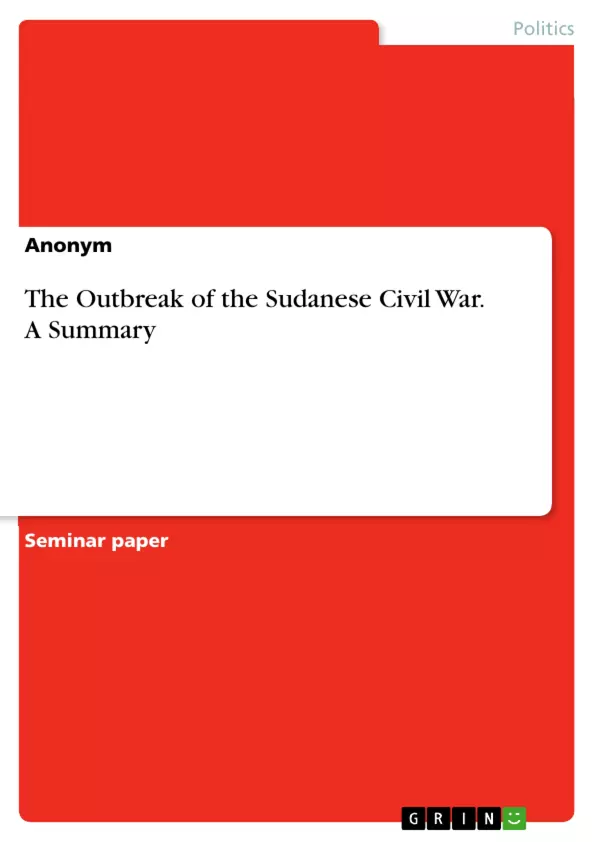The main purpose of this paper is to analyse the period of the Addis Ababa Peace (1972-1983) in Sudan and the outbreak of the second Sudanese Civil War between North and South Sudan.
This paper assumes that the outbreak of the second civil war took its roots from the struggle between elites to maintain political power and economic enrichment rather than the known ethnocultural or religious differences between the North and the South Sudan.
Inhaltsverzeichnis (Table of Contents)
- A Theoretical Prologue
- Introduction
- The Background of the First Civil War in Sudan
- The Anya- Nya Movement and the First Civil War
- The Addis Ababa Peace
- The North Sudanese Government and the Results of the State Weakness
- The Al-Numeiri Regime and the Political Fractions in North Sudan
- The National Reconciliation and the Muslim Brotherhood
- The South Sudan and Its Motives
- The Southern Self-Government and the new Tensions
- The Emergence of the Sudan Peoples Liberation Army/Movement and the Outbreak of the Second Civil War
- Conclusion
Zielsetzung und Themenschwerpunkte (Objectives and Key Themes)
This paper aims to analyze the period leading up to the outbreak of the second Sudanese Civil War, focusing on the Addis Ababa Peace period (1972-1983). It argues that the outbreak of the second civil war was rooted in the struggle for power and economic enrichment among elites rather than simply ethnic, cultural, or religious differences between North and South Sudan.
- The role of elites in the outbreak of the second Sudanese Civil War
- The impact of the Addis Ababa Peace on the political landscape in Sudan
- The emergence of the Sudan Peoples Liberation Army/Movement
- The significance of economic factors in the outbreak of civil war
- Different theoretical approaches to understanding civil war
Zusammenfassung der Kapitel (Chapter Summaries)
- A Theoretical Prologue: This chapter introduces the theoretical frameworks used in the paper, arguing that civil war is an actor-oriented phenomenon driven by elite power struggles. It examines two dominant theoretical approaches to civil war: one emphasizing collective grievances and the other focusing on economic greed.
- Introduction: This chapter provides an overview of the historical context of civil war in Sudan, highlighting its status as a "failed state" and the devastating impact of the conflict. It outlines the structure of the paper and its focus on different time periods and actor relations.
- The Background of the First Civil War in Sudan: This chapter explores the historical roots of the conflict between North and South Sudan, emphasizing the role of British colonial rule in exacerbating existing tensions. It examines the emergence of the Anya-Nya movement and the subsequent outbreak of the first civil war.
- The North Sudanese Government and the Results of the State Weakness: This chapter analyzes the period after the first civil war, focusing on the instability and political maneuvering within the North Sudanese government. It examines the impact of the Al-Numeiri regime and the role of the Muslim Brotherhood.
- The South Sudan and Its Motives: This chapter explores the dynamics in South Sudan during the Addis Ababa Peace period, examining the emergence of new tensions and the rise of the Sudan Peoples Liberation Army/Movement. It investigates the factors that ultimately led to the outbreak of the second civil war.
Schlüsselwörter (Keywords)
The key themes of this paper revolve around the outbreak of the second Sudanese Civil War, exploring the interplay of elite power struggles, political instability, economic factors, and the historical context of the first civil war. It delves into the role of the Addis Ababa Peace period, the emergence of the Sudan Peoples Liberation Army/Movement, and the theoretical approaches to understanding civil war, such as those emphasizing collective grievances and economic greed.
- Quote paper
- Anonym (Author), 2008, The Outbreak of the Sudanese Civil War. A Summary, Munich, GRIN Verlag, https://www.grin.com/document/346842



